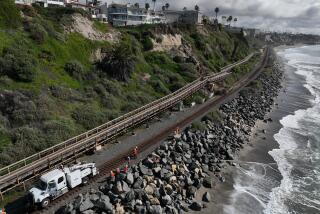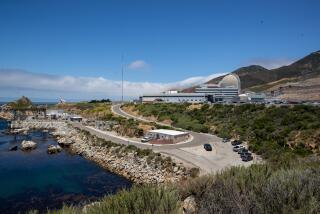San Onofre nuclear plant operators propose seismic study
The operators of the San Onofre nuclear power plant are proposing a multimillion-dollar study that would use new technology to better assess seismic conditions near the northern San Diego County complex.
The announcement by Southern California Edison followed calls in the wake of the Japanese nuclear crisis by state and federal officials for comprehensive reviews of the state’s two commercial nuclear power plants, which are both located along the coast. Also Wednesday, lawyers for a former manager at San Onofre announced they had filed a lawsuit against the company, saying the man was fired after he raised other employees’ safety concerns with the Nuclear Regulatory Commission.
Edison officials said the new study was long-planned but that the scope of the project was being reevaluated in the wake of the Japanese crisis. Authorities at the afflicted Fukushima nuclear power facility in Japan have struggled since a March 11 quake and tsunami there to bring the plant under control and limit damages, which already include leaked radiation and the contamination of plants and water.
In recent weeks, several officials and local residents have questioned whether operators of San Onofre, near San Clemente, and the Diablo Canyon nuclear plant, on the Central Coast, are truly prepared for the potential severity of earthquakes and tsunamis.
This month, California Sens. Barbara Boxer and Dianne Feinstein called on the NRC to perform a thorough inspection at both plants that would assess their safety and emergency preparedness and to answer specific questions about potential seismic threats.
San Clemente residents have also raised concerns about safety. Last week, the City Council asked plant officials and the NRC to report to the city in the next two to three months on the implications of the Japanese crisis for the San Onofre facility.
In the suit filed Tuesday, Paul Diaz, a 10-year employee at the plant, said he was fired after he told his superiors about safety concerns that he had heard from other employees, who said they were not comfortable raising certain issues with management. The employees’ concerns included being made to work excessive amounts of overtime, Diaz’s lawyers said.
Jointly owned by Edison, San Diego Gas & Electric and the city of Riverside, the twin reactor units at San Onofre can generate 2,200 megawatts of power, enough to meet the needs of 1.4 million average homes at a point in time, according to the plant’s website.
Edison officials said the San Onofre plant is safe and was made to withstand a magnitude 7 quake from a fault five miles away and is protected by a 30-foot seawall.
The proposed study would tap into new technology that could lead to a more accurate threat assessment, said Edison spokesman Gil Alexander. It would include doing 3-D reflective mapping offshore that could be used to detect hidden earthquake faults.
The project would be conducted by a contractor hired by Edison, Alexander said, a fact that troubles some critics.
“It is a positive step that Edison has agreed to this additional work,” said Dan Hirsch, a nuclear policy lecturer at UC Santa Cruz and president of the Committee to Bridge the Gap, an anti-nuclear group. “But it is critical [that] it be truly independent…one needs an honest appraisal of the seismic risks.”
The plan must first be approved by the California Public Utilities Commission, because its cost would be covered by a small increase in rates, Alexander said.
He emphasized that a study submitted by Edison to the commission in February reinforced the original specifications to which the facility was built in the 1980s. That study concluded that San Onofre could continue to operate reliably through its current license period, which expires in 2022.
“All of the best current available data still point in the direction of how the plant was designed,” Alexander said. “San Onofre can protect the public. That’s obviously the bottom line.”
More to Read
Start your day right
Sign up for Essential California for news, features and recommendations from the L.A. Times and beyond in your inbox six days a week.
You may occasionally receive promotional content from the Los Angeles Times.







